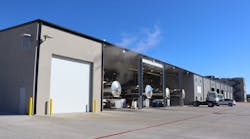MEXICO is immersed in an ambitious program to do to four markets—gas, crude oil, petrochemicals, and electricity—what the United States did to one market (natural gas) in seven years, according to Rusty Braziel, featured luncheon speaker on May 23 during the International Liquid Terminals Association’s 2016 International Operating Conference in Houston, Texas.
In his presentation, “Going to Mexico! New Opportunities in Mexico’s Oil & Gas Markets,” Braziel of RBN Energy said Mexico’s new energy market started on December 20, 2013, when Mexican President Enrique Peña Nieto signed historic constitutional reforms related to Mexico’s energy sector aimed at reversing oil and gas production declines and 75 years of a nationalized market.
On August 11, 2014, secondary laws were passed to implement those reforms and officially open Mexico’s oil, natural gas, and power sectors to private investment.
That provides for:
• Maintaining state ownership of subsoil hydrocarbons resources, but allowing companies to take ownership of those resources once they are extracted and to book reserves for accounting purposes.
• Creating four types of contracts for exploration and production in: service contracts, profit-sharing contracts, production-sharing contracts, and licenses.
• Opening refining, transport, storage, natural gas processing, and petrochemicals sectors to private investment.
• Transforming Pemex into an autonomous company.
• Strengthening regulatory agencies.
“Blocks/contracts are awarded to private operators under competitive tender,” Braziel said. “On the downstream side, there’s full liberalization for ownership and operation of natural gas, liquids and products pipelines and terminals by private players. Natural gas transportation business was divested from Pemex into a separate company: CENAGAS. Liquids terminals and pipelines are owned by Pemex subject to a mandatory open season. Marketing business is open to private parties. Both private and federal government-anchored pipeline projects are permitted.
“So it’s a completely different world. These are huge changes. For any government to reverse 75 years of nationalistic policy, there must have been a big problem.”
He said Mexico’s crude oil production is down from 2.5 million barrels a day to 2.2 million—or down 12%—in the past three years, and gas is down 8%. Peak production was reached in 2004 with 3.5 million barrels a day, 67% of it coming from the Cantarell Field that was discovered in 1976.
“It’s a shadow of its former self,” he said. “If other fields were increasing in order to make up the difference, then it would have been alright. But unfortunately that’s not the case. Heavy oil production has been falling off like a rock. The majority of this stuff is not being processed in Mexico refineries. A lot is coming to the United States and other markets. Because of that, foreign earnings have been impacted.
“Light crude and super light crude are not down much, so the majority of the decline is heavy crude oil, which has implications for opportunities in that marketplace.”
The Northeast Marine area is half of the total production. That’s where the Cantarell is, and that’s where big declines are happening. Southwestern Marine is up a bit, and the Northern and Southern are down.
“Why are things falling off and not recovering?” he asked. “We know that pretty well in the United States. If you’re not drilling, you’re not going to be recovering anything. Mexico has gone from 120 rigs running in January 2013 to only 23 running in January 2016. That has resulted in far less development of wells that could potentially bring production back. Since there are fewer rigs, there are far fewer wells, meaning we are not seeing anything remotely like a recovery. It’s the same reason in the United States—because crude oil prices are down 50-60%, therefore there’s less money to be spent on these developmental activities.”
The United States was importing 1.6 million barrels of crude oil a day from Mexico 10 years ago, and now that’s down to 700,000 barrels a day.
“Back in the good old days, Mexico was responsible for 16% of all US oil imports and was the second-largest exporter to the United States,” he said. “Now it’s down to 9%, and they’re the fourth-largest importer. Saudi Arabia and Venezuela have passed Mexico. Mexico’s LPG imports from the United States are going the other way, from less than 40,000 barrels a day in 2010 to 140,000 already in 2016. Most of this is going to areas that don’t have access to natural gas. The bottled-gas business is really picking up, and a lot of those barrels are coming from the United States, both on ship and across the border via rail.”
He said Mexico’s natural gas imports from the United States are an even bigger story. Imports went from 1 bcf a day in 2010 to 2 bcf in 2014, and then over the course of last year were up to 3.5 bcf a day. Much has been coming from the Rio Grande export point, which is mostly Eagle Ford gas.
US crude oil production was up from 5 million barrels a day in 2006 to at 9.7 million barrels a day in April 2015, and has dropped down to 8.8 million barrels a day. Natural gas went from 50 bcf in 2006 to nearly 75 bcf this year.
“Natural gas was the first beneficiary of shale technologies, so when the global economy started growing again, crude oil and natural gas liquids ramped up,” he said. “Natural gas was already in an oversupply situation and sat there for a while as the other two commodities ran up. What would producers do in a situation like that? Gas is cheap, natural gas liquids and crude oil are expensive, let’s go drill more from natural gas that has a lot of natural gas liquids in it—called wet gas—and that’s precisely what they did. Natural gas liquids production started to increase as we got into 2012, they had too much of the stuff, and the price declined. In 2014, every producer shifted off dry gas and off of wet gas and started to drill more for crude oil production, which started increasing, and it was inevitable that exact same thing would happen there. Crude oil prices crashed just like natural gas liquids had before and natural gas before that. I like to call that period from 2009 to 2014 ‘Shale 1.0.’ Why? Well, back in those days, every time a commodity crashed, I as a producer moved to the next-best commodity. But now I’m in ‘Shale 2.0.’ All prices are bad; all prices are low. I don’t have any more commodities I can go to. Now I have to deal with the situation.
“We’re drilling far fewer wells. There are certain things that are supposed to work in certain ways. One of those things is that if crude oil and gas prices are lower, we should be drilling a lot fewer wells. And lo and behold, it works exactly the way it’s supposed to. It’s almost a 100% correlation between rig count and the price of crude oil. Production increased during this entire time. How could production be increasing when we have fewer rigs being used to drill? On October 14, 2015, right before all this started, we had 1,609 rigs operating. As of last week, there are 318 rigs operating. That’s 1,200 rigs sitting idle.”
Eagle Ford has shown huge productivity gains, with a 65% decline in drill time, 190% increase in wells per rig, 88% increase in 30-day average IP rate, and 407% increase in IP additions per rig per year.
“With this much productivity improvement, what is going on?” he asked. “We can always export to Canada. Canada was OK. They’re our friends. So we started exporting a lot of crude—over 100,000 barrels a day in 2013 and up to 500,000 a day in 2015. The majority of the increase of exports we’re seeing are to Canada and coming from the US Gulf Coast from small tankers that were headed up to Canada. That will change.
“Eagle Ford has completely dropped out of the Canadian picture. Overall exports are about the same but what’s happened is barrels are now going to other places: Europe, Latin America, the Asian Pacific. Lots of barrels are still moving out, but exports haven’t really taken off. It hasn’t been a big deal at all for the US market. We still import 7.5 to 8 million barrels every single day of crude oil. It comes from Canada, Saudi Arabia, Mexico, and Venezuela. That means for every barrel we export, we’ve got to import a barrel to replace it. And for every barrel that production falls off, we have to replace that barrel that has fallen off by imports.
“Where is the majority of that falling off happening? It’s Eagle Ford, which is just across the border from Mexico. Eagle Ford has had a big problem. The rig count in October 2014 was 233. As of last week, there were 33 rigs—27 for crude, six for gas. Eagle Ford production increased faster than any other basin in the United States when things were good, and when things turned sour, Eagle Ford has fallen off, so the vast majority of decline in total US production has come from Eagle Ford. That is not good news for those who are looking right across the border and trying to say, ‘How is this going to shake out?’ That means there’s a problem with the drilling economics in Eagle Ford.”
Braziel said there are three scenarios for crude prices by 2021: $60 a barrel if there is growth, $50 is there is a cutback, and $40 if there is contraction.
In terms of producer economics, he said there is more to it than price.
“You also have volume,” he said. “Because of efficiencies and improvements in operations, volumes have been increasing. That means their rates of return are improved.
“The other leg in the stool is cost. Put lower cost together with higher volume and unfortunately lower prices, and you can calculate what a given producer can make with a well and what that means in terms of the likelihood of them drilling how many wells in a given period of time.
“Production ramped up from 2008 to 2015. If we get high crude oil prices—$60—then we’ll continue to grow production up 160,000 barrels of crude oil a day. If prices are low, we could decline by as much as 225,000 a day, which means there’s a big difference between how much crude oil gets produced if prices are high or low. Natural gas works exactly the same way. If natural gas prices are high, we’re going to have a million barrels a day more. So depending on what happens to prices, that says a lot about what happens to total production in the United States.
“Meanwhile production in Mexico continues to grow: 300,000 barrels a day from unconventional (shale), 500,000 from exploration, 400,000 from farm-outs—other folks that are coming in with their money that are going to help things out. This might not happen, though. If farm-outs don’t happen, if exploration numbers don’t happen, if shale doesn’t happen, then production of crude oil in that market would continue to fall. That would be a bad thing for Mexico’s supply and demand balance of petroleum products.”
Braziel said there are 22 natural gas pipeline projects in Mexico.
“They’re being built like there is no tomorrow,” he said. “Why are they doing that? That much capacity is needed to be able to get gas to where it’s needed. A pipeline only goes from A to B, so you have to be able to take it there. Secondly, it gives a lot of optionality. There are lots of ways I can change things around and make it happen. Also, these pipelines are large and oversized. That’s surrogate storage.”
He said there are only six refineries in Mexico, and they are expected to spend $2.5 billion on ultra-low sulfur gasolines and $3.3 billion on ultra-low sulfur diesel.
“That does not increase refining capacity, so crude oil production is going down,” he said. “So imports from the United States will go up. It looks like to us that there will be a lot of petroleum products heading across the border into the Mexico market to balance that market out. But it all depends on price. Supply is really a function of price. What is likely to happen to price?
“There is a base of production in North America that can come on line within months of a sustained price signal over $50 a barrel. This base level of production does not disappear at lower prices—it is simply put on hold. A base level of oil and gas production will act as a price cap. Whenever prices increase, production growth will resume and price increases will be cut back.” ♦









![Byrne Evans [center], International-Matex Tank Terminals, and J J Griffin, South Coast Terminals, receive 2016 Safety Improvement Awards from ILTA President Melinda Whitney. Byrne Evans [center], International-Matex Tank Terminals, and J J Griffin, South Coast Terminals, receive 2016 Safety Improvement Awards from ILTA President Melinda Whitney.](https://img.bulktransporter.com/files/base/ebm/bulktransporter/image/2019/04/bulktransporter_766_ilta_safety_e.png?auto=format,compress&fit=crop&q=45&h=139&height=139&w=250&width=250)
